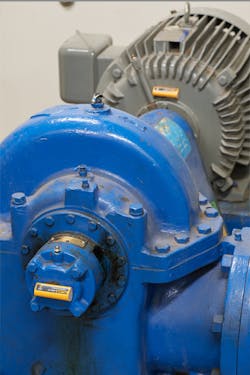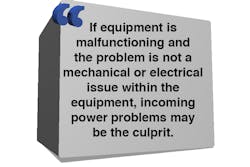How to combine vibration screening with other techniques to strengthen predictive maintenance strategies
When a patient goes to the emergency room for treatment, initially, a triage nurse uses a thermometer, a blood pressure cuff, an oxygen level detector and often other instruments and tools to obtain readings on the patient’s general condition. This data gives the nurse information about the patient, and one measurement is typically not enough data to draw any conclusions or make assumptions.
For example, an elevated temperature with no other symptoms may lead the nurse to send the patient back to the waiting room to wait for the next available room. An elevated temperature with low oxygen levels and difficulty breathing may indicate that the patient may need immediate and urgent attention. Without the patient’s oxygen reading and/or breath sounds, a person in distress may be sent back to the waiting room, when in reality, immediate action should be taken.
The same is true for assets — such as pumps, compressors, motors, fans, electrical panels, process equipment and HVAC systems — in every facility. An elevated temperature reading could indicate many potential problems. However, elevated temperature with other symptoms may more quickly predict a potential failure. Because of this, all technologies (mechanical, electrical and thermal) and types (portable, wireless and software) should be leveraged to monitor and assess equipment. Finding tools and technology that are cloud-based to automatically aggregate data for analysis is strongly recommended. This article discusses the use of vibration screening in tandem with data from the following condition monitoring technologies:
- Ultrasound
- Temperature
- Thermal
- Power monitoring
- Current and voltage monitoring
Monitoring vibration helps find potential problems, particularly in rotating assets such as pumps, motors, fans and compressors, at an early stage.
Vibration screening
While vibration analysis is one of the most effective ways to detect and prevent equipment failure or downtime and identify early failure modes, performing vibration analysis can be complex. Vibration analyzers typically require advanced training, third-party experts, or are too expensive to use on most equipment, leaving significant gaps in maintenance programs. However, simplified vibration screening combined with other types of portable and wireless condition monitoring can speed up a facility’s journey to reliability.
Monitoring vibration helps find potential problems, particularly in rotating assets such as pumps, motors, fans and compressors, at an early stage. Only ultrasound and perhaps oil analysis can detect faults earlier, but this can often be too early for repair action.
Vibration sensors identify vibration peaks of machine components to detect common faults such as:
- Misalignment
- Imbalance
- Looseness
- Bearings that are about to fail due to mechanical, lubrication or wear problems
By comparing patterns of the vibration peaks to those found in a database from similar healthy machines, end users can determine the severity of the machine fault and recommend a repair or other action.
Ultrasound
From the beginning of bearing failure to leak detection, ultrasound:
- Is the best technology for detecting and localizing air leaks, steam traps, valves, tank tightness, partial discharge and bearing lubrication
- Provides a good early warning of bearing issues but further testing is needed with vibration analysis to determine when repair action is needed
- Provides a good early warning of electrical problems (before opening an energized panel) but further testing is needed with thermography
Contact and non-contact temperature monitoring
Overheating is a major predictor of impending component failure in rotating equipment like pumps, motors, fans, compressors and electrical panels. There are two methods for measuring temperature: non-contact and contact. Wireless contact temperature sensors can be attached inside electrical panels or operating equipment to stream readings to a Computerized Maintenance Management System (CMMS). The results can be remotely monitored from a mobile device or a PC.
Thermal/infrared imaging sensors or handheld tools are great frontline, non-contact temperature measuring tools for monitoring components because a technician can stand at a distance and scan the equipment while it operates. Using a handheld infrared camera (also called a thermal imager) or streaming measurements from a thermal imaging sensor, technicians can quickly detect overheated bearings and couplings, hot spots in motor casings, faulty connections in high-power electrical circuits and equipment and overheated junction box cases.
Thermal imaging can also be used to locate leaks and estimate fluid levels in sealed vessels and tanks, monitor insulation performance in process pipes or other insulated processes, and identify problems in electrical switch gear. Thermography is a good tool for confirming faults trended over time and diagnosed using vibration analysis — temperature increases are easily identified by thermal sensors in the later stages of bearing, seal and coupling wear.
Power monitoring
If equipment is malfunctioning and the problem is not a mechanical or electrical issue within the equipment, incoming power problems may be the culprit. Streaming logged data from a three-phase power monitor will enable personnel to see trends and fluctuations that can point to power problems, such as harmonics, short circuits or high-voltage transients from lightning. Although power monitoring to catch the event is critical, it should be combined with other technologies (such as vibration or thermal imaging) to get a complete picture of the issue.
Current and voltage monitoring
Monitoring current and voltage provides key information on how machinery is performing and can help identify and address situations that may cause shutdowns such as when:
- A baseline current or load at a critical pump is trending close to the motor’s maximum current rating
- The total power at an induction furnace fluctuates abnormally during a curing cycle
- A submersible or hydraulic pump is not maintaining flow or pressure
By measuring current and voltage from startup through normal operation, problems with inrush current, intermittent voltage spikes and sags, or other conditions that may cause tripped circuits and faulty operation can be identified. These measurements are most often captured with a digital multimeter (DMM), clamp meter or semifixed condition
monitoring sensor.
Many of the metrics listed above apply to multiple assets in a manufacturing or processing facility. Each asset may require tracking several of the above-listed metrics. The acceptable values will vary from one type of asset to the next. A perfect example is to combine vibration with thermal imaging. Collecting the vibration measurement alone may not provide the potential issues with the motor. Although it will indicate potential bearing failure, it may not show increased temperature because of insulation degradation, while a thermal camera will show an increase in temperature.
Power monitoring with a three-phase power monitor will enable personnel to see trends and fluctuations that can point to power problems such as harmonics, short circuits or high-voltage transients from lightning.
Pumps
Pumps are one of the most common assets in plants and other facilities. They are integral to many critical systems including HVAC, processing, temperature control and safety. A pump failure can cause a shutdown of a critical process or area and cause safety problems. Pump shafts that are loose, misaligned or imbalanced can accelerate bearing and seal wear, which causes early failure. Many technologies can be used to detect pump problems including vibration or temperature/thermal measurements (later stages) to detect bearing failure.
Motors
Motors are critical to multiple aspects of production in manufacturing and process plants. They are costly to replace so preventive and predictive maintenance are critical to keeping them in top operating condition and extending their service life. Motor shafts that are loose, misaligned or imbalanced can lead to accelerated bearing wear, which causes early failure of the motor.
In addition, motors not running at optimal performance use a lot more energy. Overheating is one of the biggest factors that can shorten motor life. Operating at a temperature of approximately 10°F above its rated value can cut in half the service life of a motor.
Key indicators to monitor to identify potential motor problems early are:
- Vibration monitoring to identify problems such as misalignment, imbalance, looseness or bearings that are worn and need repair action or require lubrication
- Thermal monitoring to monitor temperature while equipment is running so technicians can quickly locate situations that require immediate attention without having to shut down the system
- In electric motors, current and voltage monitoring helps determine if the motor operates correctly, and if problems exist, these data will inform on whether the problem is electrical or mechanical
Fans and blowers
Fans and blowers experience vibration problems for many reasons, including:
- Fan blade rubs
- Shaft and casing misalignment
- Shaft and fan blade imbalance
- Product buildup or erosion of the fan blades
Without early detection and correction, other faults may result, such as a permanently deformed shaft, bending of the shaft and reduced clearances. If left unchecked, these may all cause efficiency losses and, ultimately, a shortened fan or blower life cycle.
The key indicators to be monitored related to fans and blowers are:
- Vibration monitoring to identify shaft and casing misalignment or blade imbalance
- Thermal monitoring to identify fan blade rub points, and product buildup that creates overheating
Variable frequency drives
Variable frequency drives (VFDs) are becoming more common as facilities strive to increase energy efficiency. A shift in the operating point from fixed speed to variable speed for a pump system with a high static head, for example, will result in increased specific energy consumption. The speed change can result in an operating point with lower pump and motor efficiency and lower power factor. Higher specific power consumption will increase production costs and negatively impact the profitability of water distribution operations.
Key indicators related to VFD performance that should be monitored include:
- Specific energy consumption, expressed as kilowatt-hours per volume of water pumped
- Vibration monitoring of the motor system
- Current monitoring of the motor system
HVAC systems
HVAC systems today are a complex arrangement of pumps, motors, fans, compressors, electrical and electronic components. Any of these can malfunction at any time. Maintaining those critical systems requires the ability to simultaneously collect and monitor multiple types of measurements — temperature, electrical, electronic and vibration — over time.
Key identifiers of HVAC system health include:
- Temperature monitoring to define HVAC typology, showing how heating and cooling are distributed
- Power quality monitoring to identify public utilities district cost versus energy used
Conclusion
The point here is to understand that one data type may offer good information and insight, but using multiple data points can provide a clearer picture of equipment status. In summary, tools that may be used to gain insight are ultrasound, temperature, thermal, power monitoring and current and voltage monitoring.
Just as medical professionals use multiple technologies to assess the health of their patients, maintenance personnel must employ different tools to monitor the health of their assets.
John Bernet, CMRP, is a mechanical application specialist with Fluke Corporation. He has more than 30 years of experience in the preventive and predictive maintenance industry. From his career with the U.S. Navy, where he first learned corrective and preventive maintenance, to his 18 years with Azima DLI and his years at Fluke, Bernet has managed, trained and mentored scores of field professionals and written a 240-page vibration training program. He is Vibration Analysis Level 2 certified and Thermography Level 1 certified. Today, he guides mechanical applications for Fluke tools and software. Bernet may be reached at [email protected].







